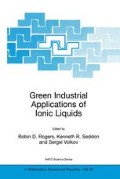Abstract
There currently exist a number of theoretical works on the study of contact melting, and the ionic liquids formed by this method. It is possible to select several directions from these studies. One of them is a study of the kinetics of growth of the fluid area in binary systems. Considering a pair of regular displacement boundaries, 1 and 2, a fluid phase forms under the conditions of contact melting, controlled by the kinetics of the diffusion process. Let the value of the concentration for the material of type B between the boundaries for the liquid phase be and for the solid phase be. During the period of time dt, the diffusion flow J L1 from the melt to the boundary allows the passage of Sdt atoms of B, where S is the area of the interface. In the same time period, the diffusion flow J s1 to the boundary in the solid phase allows the passage Sdt atoms of B. If the quasiequation, and, do not change during the process, the difference (J L1—J s1) must be created in the volume element Sd/1 at the boundary, and the difference of material B must equal During the time period dt, the boundary will move a distance d/1. Thus: Using Fick’s first law: where f 1(t) is a function of time. Expanding the terms from equation where α1 and b1 are time-independent parameters.
Kabardino-Balkarian State University, Nalchik, Kabardino-Balka
Access this chapter
Tax calculation will be finalised at checkout
Purchases are for personal use only
Preview
Unable to display preview. Download preview PDF.
References
Popov A.A. (1951) The accelerated definition of the diffusion factor’s in the melts systems, J. Zavodskaia Laboratoria, 6, 684–688.
Chebzuthov A.A. (1971) About the Nature and some Laws of Contact Melts, University Press, Nalchik, Russia, p. 192.
Chebzuthov A.A. and Savintsev P.A. (1971) Contact melts of crystals, VINITI Preprint No 2350-70 (18).
Savintsev P.A., Zil’berman P.P., Savintsev A.P. (1987) Physics of Contact Melts, University Press, Nalchik, Russia, p. 78.
Zil’berman P.F. (1981) Use of numerical methods for the research of contact melts of ionic crystals, VINITI Preprint No 1097-81 (4).
Savintsev, P. A., Averichieva, V. E. and Kostyukevich, M. V. (1960) The speed of the contact melting of alkali halide crystals, Izvest. Vysshikh Ucheb. Zavedenii, Fiz., 107–109.
Grot, S.Ds. and Mazyr P. (1964) Thermodynamics, Mir, Moscow, p. 219.
Potter D. (1975) Computing Methods in Physics, Mir, Moscow, p. 392.
Zil’berman P.F., Savintsev P.A. and Abibulaev R.A. (1985) Use of numerical methods for the analysis of the influence of an external field on the process of contact melts, VINITI Preprint No 2671-85 (12).
Zil’berman, P. F., Savintsev, P.A., and Gazaryan, R. M. (1986) Study of the concentration distribution in contact melting in a temperature-gradient field, Inzh.-Fiz. Zh., 51, 822–824.
Ralson A., Wilf W. (1966) Mathematical Methods for Digital Computers, Wiley, New York.
Cheerman D.B. (1990) Methods of Computer Experiments in Theoretical Physics, Nauka, Moscow, p. 176.
Metropolis, N., Rosenblum, A. W., Rosenbluth, M. N., Teller, A. H., and Teller, E. (1953) Equation-of-state calculations by fast computing machines, J. Chem. Phys., 21, 1087–1092.
Wood, W.W. (1968) Monte Carlo studies of simple liquid models, Phys. Simple Liquids, 115–230.
Alder, B. J., Frankel, S.P. and Lewinson, V. A. (1955) Radial distribution function calculated by the Monte-Carlo method for a hard sphere fluid, J. Chem. Phys., 23, 417–419.
Wood W.W. and Parker F.R. (1965) J. Chem. Phys. 42, 720–745.
Khaimenov, A. P., Goryaeva, L.I. and Lystsov, A. A. (1987) Simulation of sodium chloride, potassium chloride, and 0.5 sodium chloride + 0.5 potassium chloride melts by the Monte Carlo method using the Gordon-Kim potential, Rasplavy, 1, 104–111.
Polukhin, V. A., Ukhov, V.F. and Dzugutov, M. M. (1981) Computer Modelling of the Dynamics and Structure of Liquid Metals.
Hocni P. and Istwood D. (1987) The Computer Simulation of the Practical Methods, p. 638.
Wilson, M. and Madden, P. A. (1994) “Prepeaks” and “first sharp diffraction peaks” in computer simulations of strong and fragile ionic liquids, Phys. Rev. Lett., 72, 3033–3036.
Joubert, L., Picard, G. and Legendre, J.J. (1998) Computational study of lanthanide halide complexes in a molten salt environment, Molten Salt Forum, 5-6, 197–200
Editor information
Editors and Affiliations
Rights and permissions
Copyright information
© 2003 Springer Science+Business Media Dordrecht
About this chapter
Cite this chapter
Gontcharenko, E.A., Zil’Berman, P.F., Znamenskii, V.S. (2003). Modelling the Liquid Behaviour of Ionic Liquids. In: Rogers, R.D., Seddon, K.R., Volkov, S. (eds) Green Industrial Applications of Ionic Liquids. NATO Science Series, vol 92. Springer, Dordrecht. https://doi.org/10.1007/978-94-010-0127-4_15
Download citation
DOI: https://doi.org/10.1007/978-94-010-0127-4_15
Publisher Name: Springer, Dordrecht
Print ISBN: 978-1-4020-1137-5
Online ISBN: 978-94-010-0127-4
eBook Packages: Springer Book Archive

